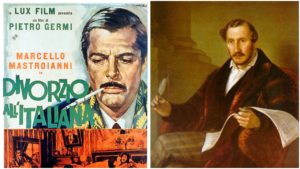
Opera Meets Film: How Donizetti’s ‘Una Furtiva Lagrima’ Structures A Scene In Germi’s ‘Divorce Italian Style’
By David Salazar“Opera Meets Film” is a feature dedicated to exploring the way that opera has been employed in cinema. We will select a section or a film in its entirety, highlighting the impact that utilizing the operatic form or sections from an opera can alter our perception of a film that we are viewing. This week’s installment features Pietro Germi’s “Divorce Italian Style.”
Rarely has an operatic passage been used to such subtle comic and structural effect than in Pietro Germi’s “Divorce Italian Style. The 1961 comedy (though it is technically an Aristotelean tragedy) stars Mario Mastroianni as Fernandino, a Sicilian nobleman trying to find a way to get out of his marriage so that he can be with his younger cousin Angela.
Per the story’s context, death seems to be the only honorable way to manage the goal, but in order to do so, Fernandino must have a justifiable reason for killing his wife Rosalia. His way out? To set her up for a love affair with another man so that his honor can be harmed, thus warranting a crime of passion.
About halfway through the film, Fernandino embarks on a montage in which he considers all the men that he could try to pull into an affair with his wife. At the apex of this montage, he and Rosalia head to the opera house to listen to Donizetti’s “L’Elisir d’Amore.” Of course, Germi picks Nemorino’s famous “Una furtiva lagrima” to structure the scene.
The aria moves from B flat minor before resolve in B flat major, thus exploring an emotional shift that reflects Nemorino’s sadness about Adina’s tears and not being with him to his joy at knowing that she adores him.
“Divorce Italian Style” plays on this emotional shift by showcasing a scene in which Fernandino moves from general frustration and indecision, to having a comic eureka moment that perfectly enjoins the musical and dramatic structure of both the story and aria.
As the scene initiates, we hear a voiceover of the protagonist as he removes his wife’s scarf to reveal her shoulders, looking around at other men that might be taking a peak at her. We see him scan the theater through his binoculars, some of the encounters revealing that he has in fact discovered a few wandering eyes. But even he can’t commit to them. This all takes place during the minor section of the aria.
At the apex of the minor section, Nemorino holds a lengthy F natural on “Sospir” that climaxes on a G natural on “Cielo,” now in B flat major. And it is at this moment that Fernandino finds his solution. In a clever wide shot, Germi starts to pan the camera from right to left, the F natural crescendoing, as the protagonist muses on finding an artistic type to suit his wife.
When the tenor hits the G natural, the camera reframes to include a two-shot between Fernandino and the main choir singer, who is completely enraptured with the aria. This reframe and the momentum of the camera move in consort with the crescendoing F natural actually have a subtle but poignant comic effect, providing the scene with an excellent payoff.
Both the musical and dramatic climaxes of the scene are fulfilled at the same time, with the greatest comedy of all being that Fernandino has had the “answer” to his dilemma sitting right beside him the whole time. Of course, the story eventually moves in a different direction, but for the purposes of this particular scene, the aria underlines the dramatic situation and its resolution quite effectively, providing contrast, but also structure to the scene.
Categories
Opera Meets Film

